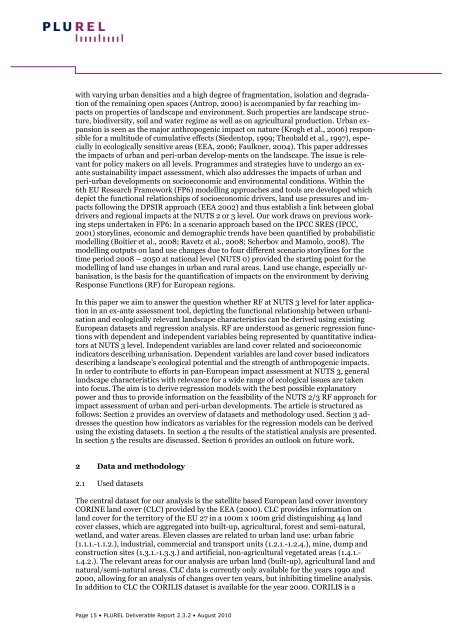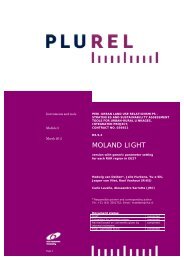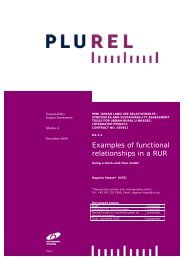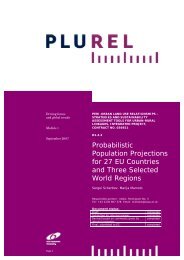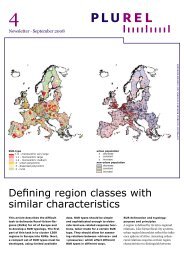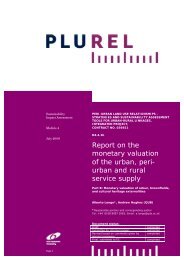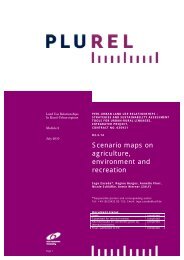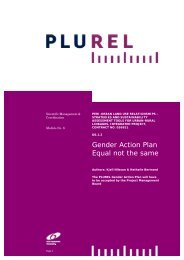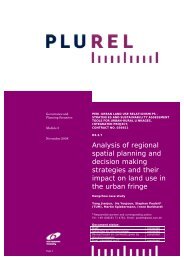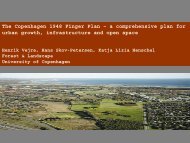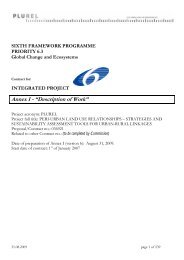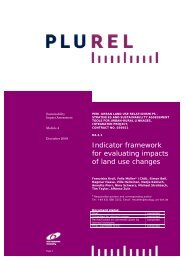Delination of response Functions - Plurel
Delination of response Functions - Plurel
Delination of response Functions - Plurel
- No tags were found...
You also want an ePaper? Increase the reach of your titles
YUMPU automatically turns print PDFs into web optimized ePapers that Google loves.
with varying urban densities and a high degree <strong>of</strong> fragmentation, isolation and degradation<br />
<strong>of</strong> the remaining open spaces (Antrop, 2000) is accompanied by far reaching impacts<br />
on properties <strong>of</strong> landscape and environment. Such properties are landscape structure,<br />
biodiversity, soil and water regime as well as on agricultural production. Urban expansion<br />
is seen as the major anthropogenic impact on nature (Krogh et al., 2006) responsible<br />
for a multitude <strong>of</strong> cumulative effects (Siedentop, 1999; Theobald et al., 1997), especially<br />
in ecologically sensitive areas (EEA, 2006; Faulkner, 2004). This paper addresses<br />
the impacts <strong>of</strong> urban and peri-urban develop-ments on the landscape. The issue is relevant<br />
for policy makers on all levels. Programmes and strategies have to undergo an exante<br />
sustainability impact assessment, which also addresses the impacts <strong>of</strong> urban and<br />
peri-urban developments on socioeconomic and environmental conditions. Within the<br />
6th EU Research Framework (FP6) modelling approaches and tools are developed which<br />
depict the functional relationships <strong>of</strong> socioeconomic drivers, land use pressures and impacts<br />
following the DPSIR approach (EEA 2002) and thus establish a link between global<br />
drivers and regional impacts at the NUTS 2 or 3 level. Our work draws on previous working<br />
steps undertaken in FP6: In a scenario approach based on the IPCC SRES (IPCC,<br />
2001) storylines, economic and demographic trends have been quantified by probabilistic<br />
modelling (Boitier et al., 2008; Ravetz et al., 2008; Scherbov and Mamolo, 2008). The<br />
modelling outputs on land use changes due to four different scenario storylines for the<br />
time period 2008 – 2050 at national level (NUTS 0) provided the starting point for the<br />
modelling <strong>of</strong> land use changes in urban and rural areas. Land use change, especially urbanisation,<br />
is the basis for the quantification <strong>of</strong> impacts on the environment by deriving<br />
Response <strong>Functions</strong> (RF) for European regions.<br />
In this paper we aim to answer the question whether RF at NUTS 3 level for later application<br />
in an ex-ante assessment tool, depicting the functional relationship between urbanisation<br />
and ecologically relevant landscape characteristics can be derived using existing<br />
European datasets and regression analysis. RF are understood as generic regression functions<br />
with dependent and independent variables being represented by quantitative indicators<br />
at NUTS 3 level. Independent variables are land cover related and socioeconomic<br />
indicators describing urbanisation. Dependent variables are land cover based indicators<br />
describing a landscape’s ecological potential and the strength <strong>of</strong> anthropogenic impacts.<br />
In order to contribute to efforts in pan-European impact assessment at NUTS 3, general<br />
landscape characteristics with relevance for a wide range <strong>of</strong> ecological issues are taken<br />
into focus. The aim is to derive regression models with the best possible explanatory<br />
power and thus to provide information on the feasibility <strong>of</strong> the NUTS 2/3 RF approach for<br />
impact assessment <strong>of</strong> urban and peri-urban developments. The article is structured as<br />
follows: Section 2 provides an overview <strong>of</strong> datasets and methodology used. Section 3 addresses<br />
the question how indicators as variables for the regression models can be derived<br />
using the existing datasets. In section 4 the results <strong>of</strong> the statistical analysis are presented.<br />
In section 5 the results are discussed. Section 6 provides an outlook on future work.<br />
2 Data and methodology<br />
2.1 Used datasets<br />
The central dataset for our analysis is the satellite based European land cover inventory<br />
CORINE land cover (CLC) provided by the EEA (2000). CLC provides information on<br />
land cover for the territory <strong>of</strong> the EU 27 in a 100m x 100m grid distinguishing 44 land<br />
cover classes, which are aggregated into built-up, agricultural, forest and semi-natural,<br />
wetland, and water areas. Eleven classes are related to urban land use: urban fabric<br />
(1.1.1.-1.1.2.), industrial, commercial and transport units (1.2.1.-1.2.4.), mine, dump and<br />
construction sites (1.3.1.-1.3.3.) and artificial, non-agricultural vegetated areas (1.4.1.-<br />
1.4.2.). The relevant areas for our analysis are urban land (built-up), agricultural land and<br />
natural/semi-natural areas. CLC data is currently only available for the years 1990 and<br />
2000, allowing for an analysis <strong>of</strong> changes over ten years, but inhibiting timeline analysis.<br />
In addition to CLC the CORILIS dataset is available for the year 2000. CORILIS is a<br />
Page 15 • PLUREL Deliverable Report 2.3.2 • August 2010


